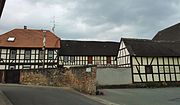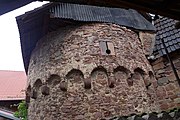Schaafheim Castle
| Schaafheim Castle | ||
|---|---|---|
|
The information board at the location of the former castle today at Straße Schlossgraben 2-4 |
||
| Alternative name (s): | Schaafheim Castle | |
| Creation time : | probably at the beginning of the 14th century, documented in 1404 | |
| Castle type : | Niederungsburg , later city palace | |
| Conservation status: | Demolished in 1823, remains of the tower | |
| Standing position : | Count of Hanau | |
| Construction: | Sandstone | |
| Place: | Schaafheim | |
| Geographical location | 49 ° 55 '18.9 " N , 9 ° 0' 25.7" E | |
| Height: | 155 m above sea level NN | |
|
|
||
The castle Schaafheim , including Castle Schaafheim called, was a small castle in the then outskirts in Schaafheim , on the edge of the Odenwald , now in the district of Darmstadt-Dieburg in Hesse located. It was converted and expanded into a city palace by the Counts of Hanau at the beginning of the 15th century.
history
Since Emperor Charles IV granted the town of Schaafheim city rights in 1368 , as with the freedoms of Hanau and Windecken , and the town was fortified with a city wall , it had a market place and the seat of jurisdiction (imperial court , lower and higher court) with one Gallows was used as a place of execution, it can be assumed that a castle existed at the latest in the beginning of the 14th century and was expanded to look like a castle at the beginning of the 15th century. Because in 1404 it was documented (for the first time) as the last residence of the Hanau Count Ulrich V as a result of his forced abdication as regent of the Hanau rulership . Later histories attempted to justify a mental disorder, much more likely it was just a reason for bypassing the Primogenitur statutes in the Hanau house.
In the partition contract of 1458 of the County of Hanau , Philip I received the Hanau-Lichtenberg share . It explicitly mentions “ Schaiffheim Castle, Village and Court ”.
The castle and town, already badly devastated in the Second Markgräflerkrieg in 1552 , were again plundered and devastated several times during the Thirty Years War . As a result of the plague, the place was completely depopulated for a short time.
Nevertheless, it can still be assumed that the Hanau house will at least temporarily live in the castle for 1615, because Countess Katharina Belgica of Orange-Nassau (widow of Philip Ludwig II ) seals in Schaafheim there.
When in 1763 the last estate of the Hanau family was moved from Schaafheim to Pirmasens , it can be concluded that the castle was no longer inhabited by this point at the latest. The reason was probably that after the death of the last Hanau count, Johann Reinhard III. , 1736, there were inheritance disputes between Hessen-Kassel and Hessen-Darmstadt . The dispute over the office of Babenhausen (Schaafheim was one of them) almost led to a military conflict. The Landgraviate of Hessen-Darmstadt succeeded in occupying Schaafheim and the town of Schaafheim became the administrative seat of the Schaafheim office. The dispute over the Hanau legacy could only be ended with a settlement in 1771 after a long-standing legal dispute before the highest imperial courts , the so-called participation recess . Schaafheim remained with Hesse-Darmstadt, the later Grand Duchy of Hesse , but was no longer of any importance for the Hesse-Darmstadt family and thus also not the castle.
The remains of the castle were now used as an orphanage and barracks. At the beginning of the 19th century only the remains of the wall and two towers were left. One of them, equipped with several rooms, served as a registry , the other was set up as a prison . After the office of Schaafheim was dissolved in 1820, the palace was unfortunately torn down in 1823 except for a few walls that are still preserved today.
Present stock
Nothing left of the castle today. The remains of a city wall tower are located exactly north of the former facility, the north side of which was directly on the city wall. However, the remains of the tower are located on inaccessible private property. (See also: List of cultural monuments in Schaafheim ) Today only the street names Schloßgraben and Burggartenstraße and a small plaque from the Schaafheimer Heimat- und Geschichtsverein remind of the bygone castle.
literature
- Rudolf Knappe: Medieval castles in Hessen. 800 castles, castle ruins and fortifications. 2nd Edition. Wartberg-Verlag, Gudensberg-Gleichen 1995, ISBN 3-86134-228-6 , p. 543.
- Johann Wilhelm Christian Steiner: Antiquities and history of the Bachgau in the old Maingau . Wailandt, Aschaffenburg 1821.
- Georg Wilhelm Justin Wagner : Statistical-topographical-historical description of the Grand Duchy of Hesse. Volume 1, Vlg.CW Leske, Darmstadt 1829, p. 209.
Web links
- Schaafheim Castle, Darmstadt-Dieburg district. Historical local dictionary for Hessen. In: Landesgeschichtliches Informationssystem Hessen (LAGIS).
- Heimat- und Geschichtsverein Schaafheim eV City history
Individual evidence
- ↑ Regesta Imperii 8, No. 4598; Heinrich Reimer: Document book on the history of the gentlemen of Hanau and the former province of Hanau = Hessian document book, second division. Vol. 3: 1350-1375, Leipzig 1894, no. 569.
- ↑ Hanauisches Magazin from 1778 , Hanau 1779, p. 343.
- ^ Georg Lehmann: Documentary history of the county Hanau-Lichtenberg in the lower Alsace , Volume 2, Mannheim 1863, p. 411.
- ↑ Hessisches Staatsarchiv Darmstadt : HStAD Best. R 21 G No. EVIDENCE; Signature: A 1 Schaafheim 1615 Nov. 3 (I)
- ^ Hessisches Staatsarchiv Darmstadt : HStAD inventory D 7, file no. 68/1
- ↑ cf. Schaafheimer Geschichtsverein: Historical tour through Schaafheim
- ^ Johann Wilhelm Christian Steiner: Antiquities and history of the Bachgau in old Maingau: III. Part: History of the city of Dieburg and topography of the former centers and offices Umstadt, Babenhausen and Dieburg . Darmstadt 1829, p. 123








